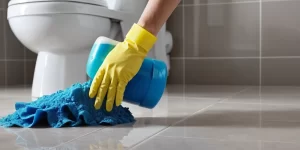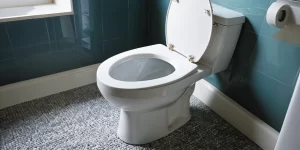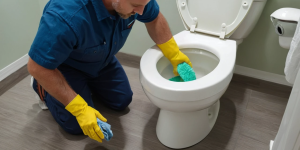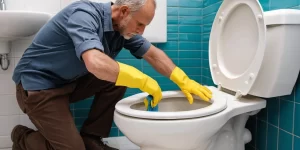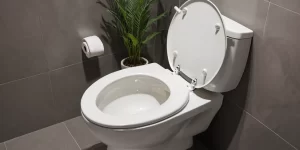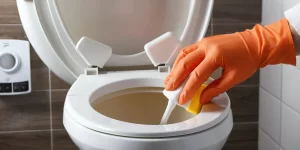Toilet bowl stains can be both unsightly and frustrating, often making an otherwise clean bathroom feel neglected. Understanding what causes these tough stains is the first step toward effective Toilet Stain Removal. Equipped with the right tools and knowledge, you can tackle even the most stubborn marks. In this comprehensive how-to guide, we will explore essential supplies, natural remedies, and effective chemical cleaners that can help you rejuvenate your toilet bowl. Moreover, we’ll provide a step-by-step approach for removing those pesky stains, alongside preventative measures to keep your toilet looking pristine. Whether you’re dealing with hard water stains or simply want to maintain a clean and fresh toilet, our expert tips and tricks will empower you to take control of your bathroom hygiene.
Understanding Toilet Stains: What Causes Them?
Toilet stains are a common nuisance that many homeowners face. Being aware of the various causes can help you better understand how to address and prevent these unattractive marks. Here are the key culprits behind the stains you might find in your toilet bowl:
- Hard Water: One of the leading causes of toilet stains is hard water, which contains high levels of minerals like calcium and magnesium. Over time, these minerals can accumulate, leaving behind unsightly deposits.
- Bacteria and Mold: If your toilet isn’t cleaned regularly, bacteria and mold can thrive in the moist environment, leading to dark stains or rings. These can easily become stubborn if not treated promptly.
- Rust: Rust from old pipes or fixtures can contribute orange or reddish stains in your toilet. This is especially common in homes with aging plumbing systems.
- Toilet Bowl Cleaners: Some commercial bowl cleaners can leave behind stains if not used correctly. It’s essential to follow the instructions carefully and avoid excessive use to prevent discoloration.
- Organic Matter: Substances like body oils, hair, or leftover cleaning products can also result in stains. These might settle at the waterline or accumulate in hard-to-reach areas.
Understanding these factors is crucial not only for effective Toilet Stain Removal, but also for preventing stains from forming in the first place. Regular maintenance and cleaning can greatly reduce these issues, leading to a cleaner and more hygienic toilet bowl.
Essential Tools and Supplies for Toilet Stain Removal
Effectively tackling those unsightly stains requires the right tools and supplies. Here’s a comprehensive list to ensure you’re well-prepared for the job:
- Toilet Brush: Opt for a sturdy toilet brush with firm bristles. This will help scrub away those tough stains without damaging the porcelain.
- Rubber Gloves: Protect your hands from harsh chemicals and germs. Comfortable, durable gloves are essential for any cleaning task.
- Pumice Stone: This natural stone can be a game-changer when dealing with hard water stains. Gentle scrubbing with a pumice stone can help restore your toilet bowl’s cleanliness.
- Cleaning Solutions: Choose either natural options like vinegar and baking soda or effective store-bought toilet bowl cleaners. Ensure that you follow the instructions and safety precautions on the labels.
- Spray Bottle: For those DIY solutions, a spray bottle can be handy. Mix your cleaning ingredients and apply them directly to the stained areas.
- Old Toothbrush or Scrubbing Pad: Use these for reaching difficult spots and scrubbing around the rim or other areas where stains tend to accumulate.
- Paper Towels or Rags: Essential for drying and wiping down surfaces after cleaning. It’s also useful for soaking up any spills during your cleaning process.
Gather these tools and supplies before starting your cleaning regimen to expedite the task and achieve the best results. Being equipped will not only help you effectively deal with stains but also make the process more enjoyable!
Natural Remedies for Toilet Stain Removal
If you’re looking for eco-friendly methods to combat unsightly stains in your toilet bowl, several natural remedies can do the trick effectively. These solutions not only help maintain a fresh environment but also often utilize household items you probably already have on hand.
Baking Soda and Vinegar Mixture
One of the most popular and effective combinations is baking soda and vinegar. Here’s how to use them together:
- Ingredients: 1 cup of baking soda, 1 cup of vinegar
- Instructions:
- Pour the baking soda into the toilet bowl.
- Follow it with vinegar, creating a fizzing reaction.
- Let it sit for about 30 minutes to an hour.
- Scrub the toilet with a toilet brush and flush to rinse.
Borax Powder
Borax is another powerful yet gentle cleaner. It can help tackle stains while also deodorizing the toilet.
- How to Use:
- Sprinkle about 1 cup of borax into the toilet bowl.
- Allow it to sit for at least 30 minutes.
- Scrub with a toilet brush and flush.
Lemon Juice
Lemon juice’s natural acidity helps break down stains and remove odors.
- Application:
- Squeeze two lemons into the toilet bowl.
- Let it sit for 1-2 hours before scrubbing.
- Flush to remove any residue.
Essential Oils
For a pleasant scent that also offers cleaning properties, consider adding essential oils.
- What to Do:
- Add a few drops of tea tree, lavender, or eucalyptus oil to the toilet bowl.
- Scrub with a brush.
- Let it sit for 10 minutes, then flush.
By utilizing these natural remedies, you can effectively eliminate stains without harsh chemicals. Sometimes a little creativity with everyday items can lead to surprising cleaning results!
Using Chemical Cleaners: What You Need to Know
When it comes to Toilet Stain Removal, chemical cleaners are often effective in tackling tough stains quickly. However, using them requires caution to ensure safety and proper usage. Here’s what you need to know:
Types of Chemical Cleaners
- Bleach-Based Cleaners: These eliminate stains and bacteria but can produce harmful fumes. Always use in a well-ventilated space.
- Acidic Cleaners: Formulated with hydrochloric or sulfuric acid, these target mineral deposits and hard water stains effectively. Use gloves and eye protection due to the corrosive nature.
- Enzymatic Cleaners: These are more eco-friendly and use natural enzymes to break down stains. They are safe for regular use.
Safety Precautions
- Read Labels: Always check instructions and warnings on the product label.
- Protective Gear: Wear gloves and a mask to avoid skin irritation and inhalation of fumes.
- Ventilation: Open windows or use a fan to help disperse any strong odors while cleaning.
Application Tips
- Follow Instructions: Use as directed for maximum efficacy and safety.
- Apply Liberally: Ensure the cleaner coats the affected areas. Allow it to sit for a recommended time before scrubbing.
By understanding these key points, you can confidently use chemical cleaners for effective Toilet Stain Removal while maintaining a safe environment in your home.
Step-by-Step Guide to Removing Stubborn Toilet Stains
Dealing with stubborn toilet stains can feel like an uphill battle, but with a structured approach, you can restore your toilet bowl to its original cleanliness. Follow these step-by-step guidelines for effective Toilet Stain Removal:
- Gather Your Supplies:
- Rubber gloves
- Toilet brush
- Pumice stone (optional, for hard stains)
- Toilet cleaner (preferably bleach-free)
- Vinegar or baking soda (for natural methods)
- Prepare the Toilet:
- Turn off the water supply to the toilet and flush to lower the water level.
- Dry the bowl area above the water line with a towel to allow easier access to stains.
- Apply the Cleaner:
- Generously coat the stained areas with your selected cleaner.
- Let it sit for at least 10-15 minutes. This gives the cleaner ample time to penetrate and break down stains.
- Scrub Away:
- Using a toilet brush, scrub the surfaces thoroughly, focusing on stubborn spots.
- For more persistent stains, use a pumice stone, applying gentle pressure to avoid scratching.
- Flush and Rinse:
- Turn the water back on and flush the toilet to remove any remaining cleaner and debris.
- Check for any remaining stains; if necessary, repeat the process.
- Final Touches:
- For maintenance, consider adding a longer-lasting cleaner to your toilet tank, which releases cleaning agents with each flush.
By following these steps diligently, you’ll be well on your way to achieving a spotless toilet. Regular cleaning and maintenance can further enhance the success of your Toilet Stain Removal efforts.
Preventative Measures: Keeping Your Toilet Stain-Free
Maintaining a clean toilet is essential not only for hygiene but also for preventing stubborn stains from developing. Implementing some simple preventative measures can save you time and effort in the long run. Here are key strategies to keep your toilet bowl in pristine condition:
Regular Cleaning Routine
- Schedule Weekly Cleans: Establish a weekly cleaning schedule to keep stains at bay. Use a toilet brush and a gentle cleaner to scrub the bowl, focusing on areas prone to staining.
- Use a Toilet Cleaner Tablet: Drop a toilet cleaner tablet into the tank to continuously release cleaning agents with every flush, helping to maintain cleanliness.
Manage Hard Water Issues
- Install a Water Softener: If you live in an area with hard water, consider installing a water softener. This will reduce mineral build-up that often causes stains.
- Regularly Inspect: Keep an eye on water hardness levels to ensure any issues are addressed promptly.
Optimize Your Flush
- Avoid Toilet Bowl Добавик: Minimize the use of heavy toilet bowl additives, as some may lead to build-up over time. Opt for natural alternatives when possible.
Educate Household Members
- Post Guidelines: Share tips with your family on what shouldn’t go into the toilet. Items like wipes, paper towels, and feminine products can lead to clogs and stains.
By combining these preventative measures, you can ensure that your toilet remains stain-free and reflects the cleanliness of your bathroom. Implementing these strategies will make toilet stain removal easier when occasional stains do occur.
How to Deal with Hard Water Stains in Your Toilet
Dealing with hard water stains in your toilet bowl can be a daunting task, but with the right techniques, you can effectively restore your toilet’s appearance. Hard water contains high levels of minerals like calcium and magnesium, which can cause unsightly stains and buildup. Follow these steps to tackle those tough stains:
Identify the Stains
- Visual Inspection: Look for white, chalky deposits or dark rings at the waterline.
- Check for Buildup: Test the surface with a light scratch; if it feels gritty, you’re dealing with hard water stains.
Essential Tools
- Pumice Stone: This natural stone can safely scrub the stains without scratching the porcelain.
- Vinegar or Baking Soda: Both are effective natural cleaners that can dissolve mineral buildup.
- Toilet Brush: For applying and scrubbing cleaners.
Step-by-Step Process
- Add Cleaner: Pour 1-2 cups of vinegar into the toilet bowl, or sprinkle baking soda on the stained areas.
- Let it Sit: Allow the cleaner to sit for at least 30 minutes to break down the mineral deposits.
- Scrub: Use a pumice stone or toilet brush to scrub the stains. Be sure to use gentle pressure to avoid scratching the bowl.
- Flush: Rinse by flushing the toilet to remove any residue.
Prevention Tips
- Regular Cleaning: Commit to cleaning your toilet at least once a month to prevent hard water stains.
- Install a Water Softener: If hard water is a consistent issue, consider investing in a water softening system to reduce mineral content.
By following these steps, you’ll find that dealing with hard water stains becomes much simpler, and your toilet will remain sparkling clean! Remember, consistent maintenance is key to avoiding buildup and eliminating the need for extensive Toilet Stain Removal efforts in the future.
The Importance of Regular Toilet Maintenance
Regular toilet maintenance is essential in ensuring a clean and functional bathroom. Neglecting this task can lead to unsightly stains and costly repairs. Here are some key reasons why maintaining your toilet should be a priority:
- Prevention of Stains and Build-Up: Regular cleaning prevents the accumulation of mineral deposits and bacteria, which can cause stubborn stains and odors. Toilet stain removal becomes significantly easier when stains are addressed promptly.
- Increased Lifespan: Toilets are an investment, and proper maintenance helps prolong their life. Routine checks can identify potential problems before they escalate into costly repairs.
- Improved Hygiene: A well-maintained toilet is not only aesthetically pleasing but also promotes a healthier environment. Regular cleaning removes harmful germs and bacteria, contributing to overall household cleanliness.
- Water Efficiency: Routine inspections allow for the early detection of leaks and inefficiencies, which can help reduce water bills. Addressing even minor leaks promptly prevents water waste and maintains the toilet’s performance.
- Enhanced Comfort and Convenience: A clean toilet ensures that it remains inviting for both family and guests. Regular upkeep minimizes the chances of unpleasant surprises during use.
Maintenance Tips:
- Clean the toilet bowl weekly with suitable cleaners.
- Inspect for leaks and fix them promptly.
- Schedule a deep cleaning every few months to maintain optimum hygiene.
By incorporating regular toilet maintenance into your cleaning routine, you can avoid pesky stains and ensure a pleasant and efficient restroom experience.
Tips for Quick Stain Fixes
When it comes to toilet maintenance, sometimes you need swift solutions to address stubborn stains. Here are some efficient tips for quick Toilet Stain Removal that can make your bathroom sparkle in no time:
Use Baking Soda and Vinegar
- Ingredients: Grab a cup of baking soda and a cup of white vinegar.
- Action: Pour the baking soda followed by vinegar into the toilet bowl.
- Wait: Let the mixture fizz and work for 10-15 minutes before scrubbing with a toilet brush.
Pumice Stone Trick
- Supplies Needed: A wet pumice stone.
- Process: Carefully rub the stained areas with the pumice stone.
- Tip: Always keep the stone wet to avoid scratching your toilet bowl.
Dish Soap Method
- Ingredients: A few squirts of liquid dish soap.
- Application: Apply directly to the stains and let it sit for about 30 minutes.
- Result: Flush, and the stains should easily rinse away.
Borax Solution
- Ingredients: 1 cup of Borax.
- Procedure: Sprinkle Borax around the toilet bowl and wait for about 30 minutes before scrubbing.
- Benefit: Borax not only helps in stain removal but also deodorizes the toilet.
Keep It Clean
- Routine: Make it a habit to scrub your toilet regularly, even if just lightly on a weekly basis.
- Prevention: This will significantly reduce stubborn stain build-up over time, making those quick fixes even easier!
By using these quick tips, you’ll be able to tackle tough stains effectively, ensuring your toilet stays fresh and clean. Remember, most of these remedies can be completed within a short timeframe, making them perfect for those urgent cleaning moments!
When to Call a Professional for Toilet Stain Problems
While many toilet stains can be tackled with at-home remedies or standard cleaning supplies, some situations warrant professional intervention. Recognizing the signs can save you time, money, and frustration. Here’s when to consider bringing in the experts:
- Persistent Stains: If you’ve tried various Toilet Stain Removal methods without success, it may be time to seek professional help. Stubborn stains can indicate deeper issues, such as mineral build-up or damage to the porcelain.
- Severe Hard Water Issues: Hard water can lead to excessive mineral deposits that household cleaners may not effectively remove. Professionals have specialized equipment and solutions that can eliminate these tough deposits.
- Damaged Toilet Bowl: If the ceramic is chipped or cracked, aggressive scrubbing or harsh chemicals can exacerbate the damage. A professional can assess the situation and recommend the best course of action.
- Plumbing Problems: Persistent stains may signal plumbing issues, like leaks or blockages. If you observe frequent stains despite regular cleaning, it’s best to consult a plumber.
- Overwhelming Odors: If you notice foul smells coming from your toilet that don’t go away after cleaning, it can indicate more serious plumbing or sanitation problems.
Remember, investing in professional services can lead to better long-term maintenance of your toilet and save you from more costly repairs down the line.
Frequently Asked Questions
What are some effective methods for removing tough stains from a toilet bowl?
To tackle tough stains in a toilet bowl, there are several effective methods you can use. One popular approach is to apply baking soda and vinegar; pour about two cups of each into the toilet, let it sit for at least 30 minutes, and then scrub with a toilet brush. For mineral stains, pumice stones can be helpful; gently rub the stone on the stains until they diminish. Commercial toilet bowl cleaners specifically designed to tackle hard water stains can also be very effective.
Why do stains appear in toilet bowls, and how can I prevent them?
Stains in toilet bowls often result from hard water minerals, rust, or organic matter, developing over time if the toilet isn’t cleaned regularly. To prevent these stains, it’s important to regularly clean your toilet bowl with a quality cleaner and brush. You can also apply a toilet bowl cleaner tablet that dissolves in water to keep stains at bay, and consider using a water softener if you have hard water in your plumbing.
Can I use bleach to remove toilet bowl stains?
Yes, bleach can be used to remove stains from the toilet bowl, but it should be used with caution. Pouring a cup of bleach into the toilet bowl and letting it sit for about 10 minutes can help remove stains and disinfect the bowl. However, be aware that bleach can cause damage to certain plumbing systems and should never be mixed with other cleaners, especially those containing ammonia, as this can create toxic fumes.
How often should I clean my toilet bowl to prevent tough stains?
To prevent tough stains from developing in your toilet bowl, it is recommended to clean it at least once a week. Regular cleaning not only keeps your toilet looking fresh but also prevents the buildup of stains and bacteria. If your household uses hard water, you may need to clean it more frequently. Monitoring the condition of your toilet bowl can help you determine an effective cleaning schedule.
Are there any natural remedies for toilet bowl stain removal?
Yes, there are several natural remedies you can try to remove stains from the toilet bowl effectively. One such method includes using a mixture of baking soda and vinegar, which together create a fizzing reaction that can help lift stains. Another option is to use white vinegar alone; pouring a couple of cups into the bowl and letting it sit can break down mineral deposits and grime. Additionally, using lemon juice can help, as its acidity can further aid in stain removal.
